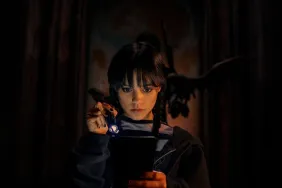ComingSoon Senior Editor Spencer Legacy spoke with director Lucky McKee about directing Old Man and implementing twists into films. Old Man is set to release on October 14, 2022, and will be available in select theaters, on-demand, and on digital storefronts.
“When a lost hiker stumbles upon an erratic old man living in the woods, he could never have imagined the nightmare that awaits,” says the synopsis.
Spencer Legacy: Stephen gives such an intense performance. What was your biggest takeaway from working with him and the depths he was willing to go to for the character?
Lucky McKee: Just that he’s a fantastic collaborator. There’s a reason Stephen Lang has over 100 credits on his IMDb page. He’s great to work with. My previous couple films, I’d been working with some pretty jaded individuals and I was not feeling great about that. By the time I ended up working with Slang on this, I was like, “Wow, this guy has been doing it for longer than a lot of us and he still has that fire in his belly,” you know? He still is fired up and still really, really cares about his craft and excelling at his craft. It was a reminder that you can keep that fire in your belly no matter how long you’ve been doing this, if you’ve got your head in the right place.
So much of the film is Stephen and Mark Senter talking and they both give great performances. What was the challenge in keeping those scenes visually interesting?
Not only as a filmmaker, but just as a person that loves film and loves watching films, it’s like my director of photography and I and the production designer and the whole team … we’re constantly pushing ourselves. How do we keep changing it up? How do we use a close-up like a weapon? When is it appropriate to pull all the way back and let the feeling of the environment inform what’s happening dramatically? So it was a really, really interesting challenge to work within such a tiny little box. When you have great actors, that really does a lot of work for you, So it’s all about just getting the camera in the best place to show what the actors are doing in the best possible light.
There’s a great flashback scene with the salesman in the middle of the film. What was your approach to filming that and going between the past and present?
That was really fun in that we were trying to tap into the feeling of somebody telling you a story and the way your mind works, if I tell you a story about my dog running down the street and almost getting hit by a car, that puts pictures in your head. So the idea there was [to], in a cinematic way, show the images that were coming into Joe’s head as the old man was telling this story. The thing that was cool about that was the way we jump in and out of that, and the way that blended together was very, very influenced by the work of Sam Peckinpah.
I think that sequence in particular, where you have a sequence in Straw Dogs where the woman goes to a magic show in town after this awful thing that’s happened to her and all these sounds and this activity around her triggering these memories of this traumatic thing that happened to her earlier in the day. That was a big jumping-off point, And the way a filmmaker like David Lynch can really use editing and imagery to simulate how the brain works, [and] how the image flashes in your brain and how memory works and how it distorts and blends together with the present. That was all swirling in our heads as we’re putting that together. A wonderful job by my editor, Zach Passero, actually.
The twist in the movie is powerful too. What was your reaction when you first read Joel Veach’s script?
My reaction was primarily to the old man character and was to his voice. I recognized that, I knew these type of people. I’d grown up in very rural kind of country environments. I knew those characters, and I thought that Joel’s script really represented that well without being judgmental, you know? That’s something that I try to remove from my observation of characters in my films, is being judgmental about what they’re doing. I want to show it and display it and dissect it, and give the audience the ability to dissect it. I don’t want to be imposing my view of right and wrong and put this moral stamp over it.
So yeah, I just really responded to that character. As far as the twist, I think that any movie that hinges on a twist being its thing that gives it success is doomed to failure. It’s not always the case, but most it is with me, personally, as a film viewer. To me, it’s all about the ride itself, you know? The coolest thing about this film, I think, is that you can watch it the first time and be feeling tension in one way and feeling this sense of mystery and everything, but once certain things are revealed to you on that first viewing, the movie literally invites you to come back and watch it again. When you do watch it again, you start to see all of this layering and all of this subconscious stuff that we were putting in there that ultimately all makes sense with the way the thing turns out. So it’s inviting second viewings for sure, hopefully.
What were some of the challenges of having such a confined area with such a small location for a lot of the film?
Fortunately, we were able to shoot this on a sound stage, so that gave us a lot more flexibility than if we were actually shooting in a tiny little cabin in the mountains. The other thing that afforded us was to be able to pack meaning into that environment — some of it blatant and some of it from a more subconscious angle. That was part of what excited me. You asked about what excited me about the script. Part of what excited me is that I had to work within this tiny box, and can I make that play? That was kind of scary, going into that. Could we keep people’s interest for 90 or 100 minutes or whatever the running time ended up being. Can you keep that dramatically engaging? Can you create enough of a feeling of mystery and can these two men retain the audience’s attention just by being super interesting with their choices and their behavior? So I feel like Mark and Stephen really pulled that off.
Stephen said you were always looking for more takes and that you were demanding, but in a good way. Can you talk about that thorough process?
I think they felt like a lot of takes to him, but honestly, we didn’t do a lot of takes per angle — but they were long takes. I mean, most days, we’d set out to shoot a six-minute run, an eight-minute run, a 10-minute run — uninterrupted — of these guys just dueling dialogue. But what that gives you performance-wise, when you’re able to sit in something for that long is even if the beginning of the take starts out a little rough and they’re not quite engaged yet, by the time they get deeper and deeper into it, the feelings and the pace and, and everything really starts to feel more organic and more like these guys are really living in the moment, you know?
Even when we got into the edit, our edit cues weren’t based on some storyboards or some rigid plan I’d had before. They were really based on this rhythm that the actors had established. There are certain cases where we had to modulate that for pace or anything like that, just to keep the story moving along. But you’ll see in the film, there are some long moments where it’s just these guys, because they were just so … they were just so plugged in emotionally. When you do three 10-minute takes going one way on one guy and then you turn around and you do four takes going the other way on the other guy, that’s a lot of time! If they’re 10 minutes a piece, that’s 70 minutes! And that’s not taking into account the time between setups. So two or three hours later, you’re still running through that same thing. But it was always in the spirit of chasing, a feeling of truth and a feeling of genuine human behavior. Also just trying things, sometimes … I joke all the time that whenever I do six or seven takes of something, it usually means I got it on the second take.
But that’s, that’s the process. When you’re shooting a film, you’re excavating a piece of marble that you’re going to carve up and turn into a statue later on. You want the biggest piece of marble that you can have, so you have room to try things. This one was just like an utter pleasure from beginning to end working on it. We had such a good time.










